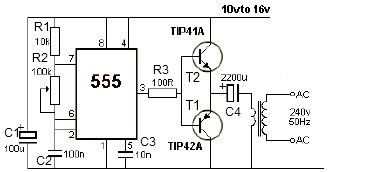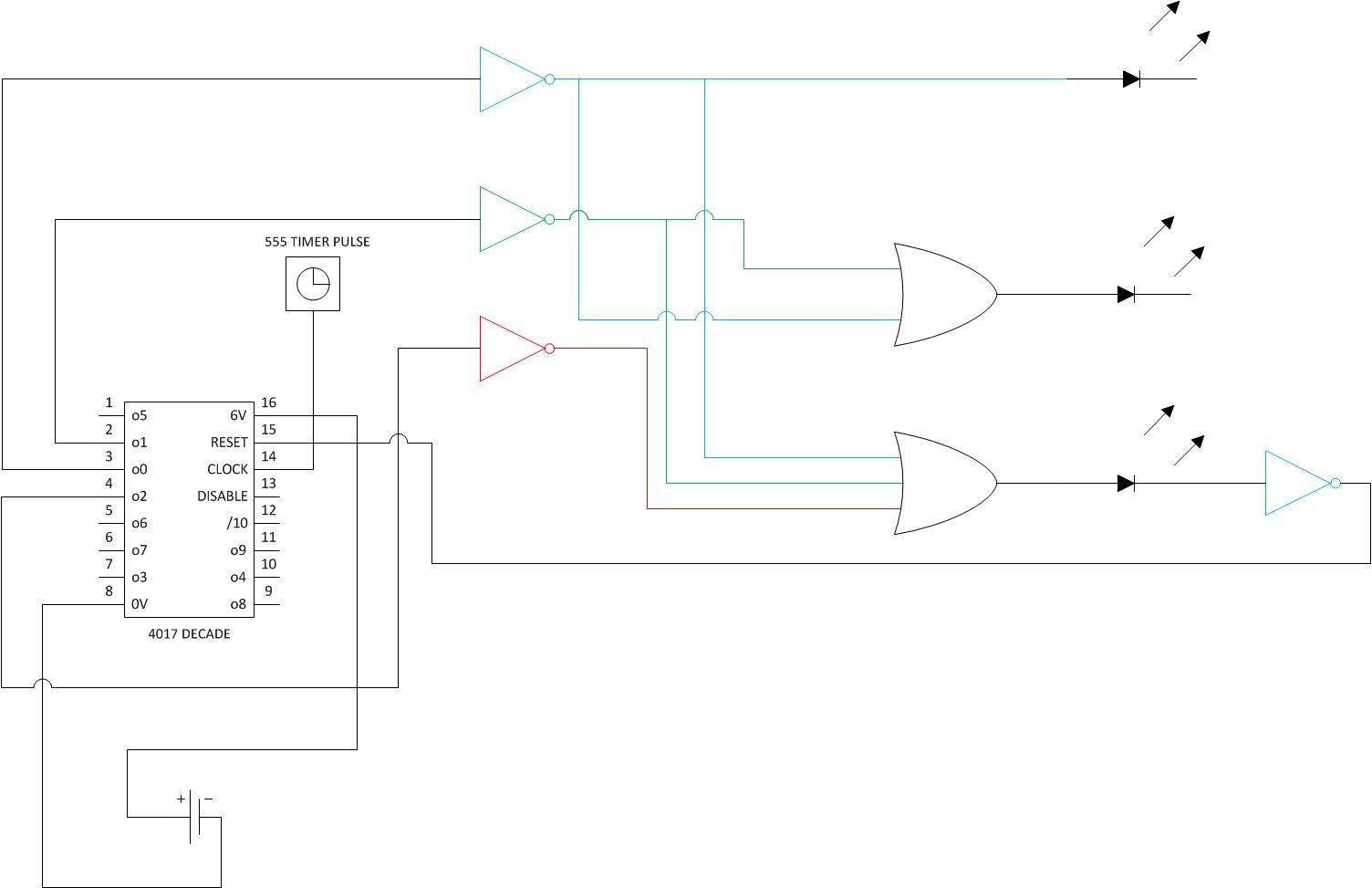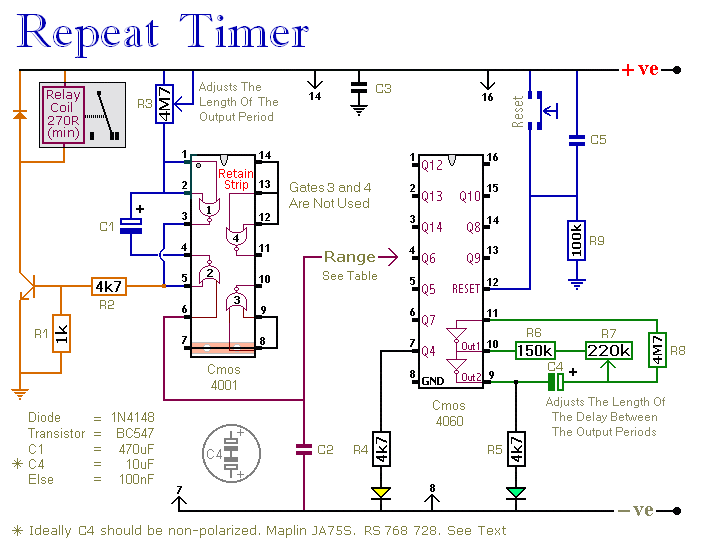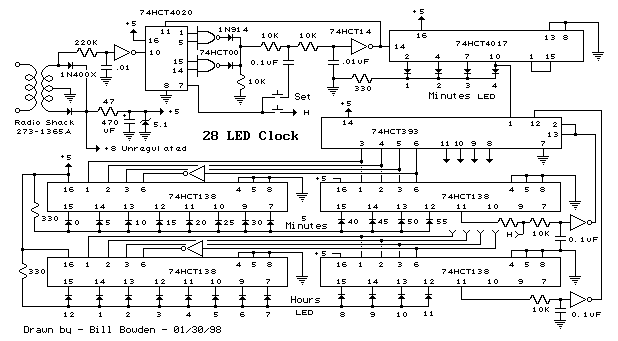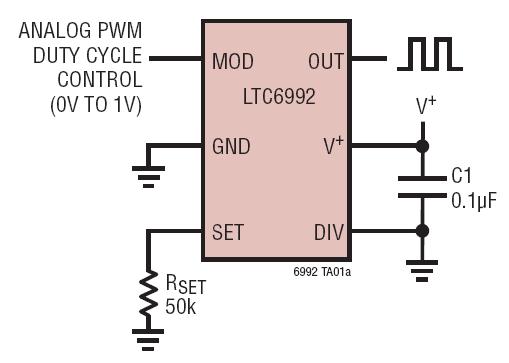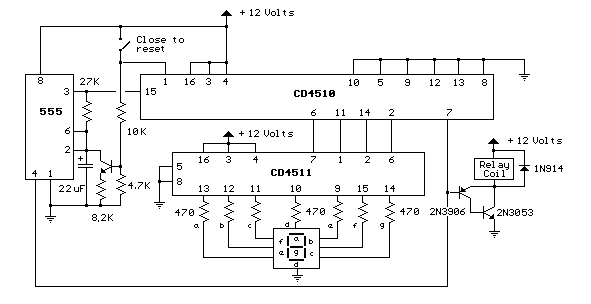
SEQUENTIAL TIMER
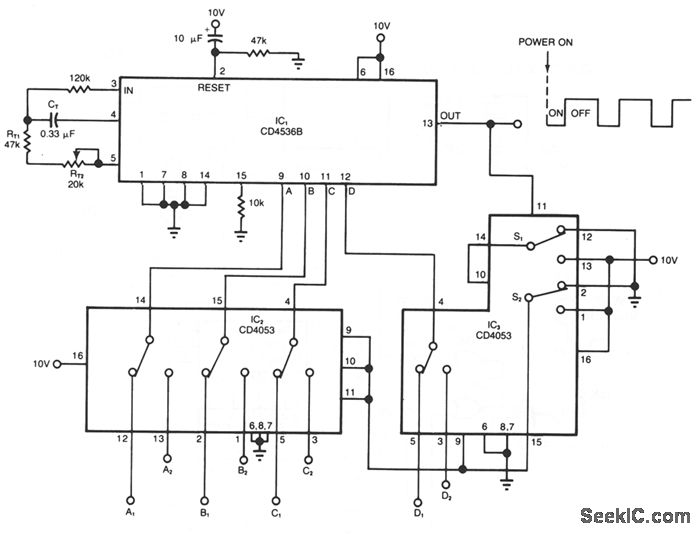
The timer circuit provides independent control of the output's on and off intervals, which can range from 0.055 seconds to 30 minutes, with minimal impact from power-line transients. IC1 is a CMOS programmable timer chip that features 24 ripple-binary counter stages; the first eight stages are bypassed when a logic high is applied to pin 6. A 4-bit code at pins A, B, C, and D connects one of the 16 remaining stages to the output at pin 13. The chip includes an oscillator with timing components CT, RT1, and RT2. In this example, RT2 is adjusted for an internal period T1N of 54.9 ms (18.2 Hz). The output on and off interval is determined by the formula T_out = T1N * 2^(N-1), where N represents the number of counter stages in the internal divider chain. IC2 and IC3 are CMOS triple SPDT analog switches that connect one BCD code (A1-D1) for the on interval and another (A2-D2) for the off interval. The codes can be applied using manual toggle switches or programmable latches. Upon initial power application, the switches are positioned to apply A1-D1 to IC1, generating the on interval. When the output state changes, all switches toggle positions to initiate the off interval by applying A2-D2 to IC1, after which the cycle repeats. To prevent race conditions, switches S1 and S2 of IC3 operate sequentially before the remaining four switches operate in parallel. To initiate the output sequence with an off interval instead of an on interval, a power-on-set signal should be connected to pin 1 rather than the power-on-reset signal at pin 2.
The timer circuit described is a versatile and robust design suitable for applications requiring precise timing control. The use of a CMOS programmable timer chip (IC1) allows for flexible configuration of timing intervals, which can be adjusted from milliseconds to minutes, accommodating a wide range of operational requirements. The internal structure of IC1, with its 24 ripple-binary counter stages, enables the generation of various timing sequences by bypassing the first eight stages as needed.
The oscillator circuit, comprising components CT, RT1, and RT2, is critical for establishing the timing frequency. Adjusting RT2 allows for fine-tuning the internal period (T1N), thus directly influencing the output timing intervals. The formula T_out = T1N * 2^(N-1) provides a straightforward means of calculating the output timing based on the selected counter stage, facilitating easy modifications to the timing characteristics.
The integration of CMOS triple SPDT analog switches (IC2 and IC3) enhances the circuit's functionality by allowing for the selection of different BCD codes for the on and off intervals. This feature enables the circuit to be controlled via manual toggle switches or programmable latches, offering flexibility in operation and ease of use. The design ensures that the output can be precisely controlled based on the desired timing sequence, making it suitable for various applications such as timers, alarms, and control systems.
To ensure reliable operation, the circuit incorporates measures to prevent race conditions during the switching process. The sequential operation of switches S1 and S2 in IC3 ensures that the circuit transitions smoothly between on and off intervals, while the parallel operation of the remaining switches allows for rapid changes without introducing timing errors.
Overall, this timer circuit exemplifies an efficient design that combines programmable timing capabilities with robust switching mechanisms, making it an ideal choice for applications requiring reliable and adjustable timing control.The timer circuit shown gives independent control of the output`s on and off intervals, which can range from 0. 055 seconds to 30 minutes, relatively unaffected by power-line transients. IC1 is a CMOS programmable-timer chip that includes 24 ripple-binary counter stages; the first eight are bypassed when logic 1 is applied to pin 6.
Then, a4-bit in put code at pins A, B, C, and D connects one of the 16 remaining stages to the output at pin 13. The chip includes an oscillator whose timing components are CT, RT1, and RT2. _For this example, you adjust RT2 for an internal period TlN of 54. 9 ms (18. 2 Hz). Then, the output on or off interval is: Tour= TIN2 N-1, where N is the number of counter stages in the internal divider chain (See Fig. 110-3). IC2 and IC3 are CMOS triple-spdt analog switches that connect one BCD code (A1 -D1) for the on interval and another (A2-D2) for the off interval.
You can apply the codes using manual toggle switches or programmable latches. When power is first applied, the switches are in the positions shown, which applies A1 -D1 to IC1 and generates the on intervat. When the output changes state, all the switches change position and initiate the off interval by applying, 42-D2 to IC1.
The cycle then repeats. To eliminate race conditions, switches S1 and S2 of IC3 operate in sequence before the remaining four switches operate in parallel. To start the output sequence with an off instead of an on interval, connect a power-on-set signal at pin 1 instead of the power-on-reset signal at pin 2.
🔗 External reference
The timer circuit described is a versatile and robust design suitable for applications requiring precise timing control. The use of a CMOS programmable timer chip (IC1) allows for flexible configuration of timing intervals, which can be adjusted from milliseconds to minutes, accommodating a wide range of operational requirements. The internal structure of IC1, with its 24 ripple-binary counter stages, enables the generation of various timing sequences by bypassing the first eight stages as needed.
The oscillator circuit, comprising components CT, RT1, and RT2, is critical for establishing the timing frequency. Adjusting RT2 allows for fine-tuning the internal period (T1N), thus directly influencing the output timing intervals. The formula T_out = T1N * 2^(N-1) provides a straightforward means of calculating the output timing based on the selected counter stage, facilitating easy modifications to the timing characteristics.
The integration of CMOS triple SPDT analog switches (IC2 and IC3) enhances the circuit's functionality by allowing for the selection of different BCD codes for the on and off intervals. This feature enables the circuit to be controlled via manual toggle switches or programmable latches, offering flexibility in operation and ease of use. The design ensures that the output can be precisely controlled based on the desired timing sequence, making it suitable for various applications such as timers, alarms, and control systems.
To ensure reliable operation, the circuit incorporates measures to prevent race conditions during the switching process. The sequential operation of switches S1 and S2 in IC3 ensures that the circuit transitions smoothly between on and off intervals, while the parallel operation of the remaining switches allows for rapid changes without introducing timing errors.
Overall, this timer circuit exemplifies an efficient design that combines programmable timing capabilities with robust switching mechanisms, making it an ideal choice for applications requiring reliable and adjustable timing control.The timer circuit shown gives independent control of the output`s on and off intervals, which can range from 0. 055 seconds to 30 minutes, relatively unaffected by power-line transients. IC1 is a CMOS programmable-timer chip that includes 24 ripple-binary counter stages; the first eight are bypassed when logic 1 is applied to pin 6.
Then, a4-bit in put code at pins A, B, C, and D connects one of the 16 remaining stages to the output at pin 13. The chip includes an oscillator whose timing components are CT, RT1, and RT2. _For this example, you adjust RT2 for an internal period TlN of 54. 9 ms (18. 2 Hz). Then, the output on or off interval is: Tour= TIN2 N-1, where N is the number of counter stages in the internal divider chain (See Fig. 110-3). IC2 and IC3 are CMOS triple-spdt analog switches that connect one BCD code (A1 -D1) for the on interval and another (A2-D2) for the off interval.
You can apply the codes using manual toggle switches or programmable latches. When power is first applied, the switches are in the positions shown, which applies A1 -D1 to IC1 and generates the on intervat. When the output changes state, all the switches change position and initiate the off interval by applying, 42-D2 to IC1.
The cycle then repeats. To eliminate race conditions, switches S1 and S2 of IC3 operate in sequence before the remaining four switches operate in parallel. To start the output sequence with an off instead of an on interval, connect a power-on-set signal at pin 1 instead of the power-on-reset signal at pin 2.
🔗 External reference
